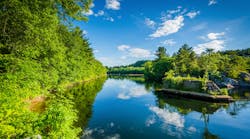I had the chance recently to “Quaff the elixir” that bubbles up from the steaming springs of Hot Springs, Arkansas. Drinking water straight out of the ground was a normal thing when I was a kid growing up in the Ozarks. Now that I’m an adult working in the water industry, it was a moderately scary experience.
“Quaff the elixir” was a term they used in the heyday of Bathhouse Row in Hot Springs, now a national park. Back then the water was touted as having medicinal properties - both for bathing and drinking. No one claims it has magical healing powers today, but drinking the water is still encouraged. In fact, they have hot water “jug fountains” at various locations in the park.
The water is naturally safe to drink when it arrives at the surface of Hot Springs Mountain and is dispensed without any form of treatment. Local town folk will tell you that the water is “naturally sterile,” but that’s not really accurate. According to literature from the park, the water does contain harmless bacteria.
The hot springs’ waters rise from an estimated maximum depth of around 8000 feet, having fallen as rain over 4000 years ago. On average 700,000 gallons emerge from the hillside every day, at an average temperature of 143° F.
The concept of “Taking the Waters” in search of a cure has always fascinated me. I don’t really believe in the idea that soaking in hot mineral water will have a medicinal effect, but I DO believe that drinking lots of water is a good thing. A few years back I lost 100 pounds on a version of the Atkins diet. Concerned about the buildup of ketones that result from being on that particular diet, I went through a period where I was drinking at least a gallon of water a day. Maybe that was overkill, but I felt the healthiest I’ve ever been during that period.
In the 1800s, springs were considered a practically guaranteed source of safe-to-drink water. Springs were categorized according to supposed mineral contents: sulfur springs, magnesia springs, chalybeate (or iron) springs, etc., and each type was considered medicinal for specific ailments.
A 1999 chemical analysis of Hot Springs water shows it contains 53 ppm of silica, 47 ppm of calcium, 130 ppm of bicarbonate (HCO3), plus trace amounts of magnesium, sodium, potassium and sulfate. It also includes 43.3 picocuries per liter of radon gas.
While park officials don’t claim the water is curative, they do certify that it is safe to drink. (I didn’t know that when I sampled the water!) The water is tested regularly by the park’s water quality laboratory and state-certified analysts.
The Hot Springs park does actually have some cold springs. Two of the jug fountains in the park are fed by these cold-water springs. While considered safe to drink, the cold-spring water is disinfected with ozone before being sent to the fountains, as required by the Arkansas Department of Health.
After working in the water industry for the past several years, I found it surprisingly hard to trust the water, even though I saw others drinking it. I guess I’ve read to much about the dangers of groundwater contamination. And I’m just not young and trusting anymore.....
James Laughlin, Editor


